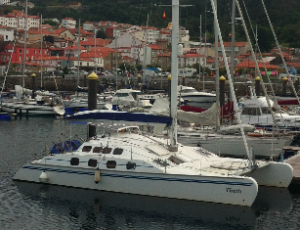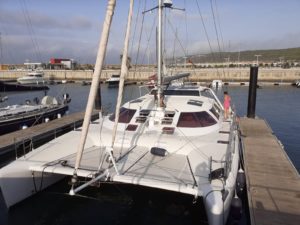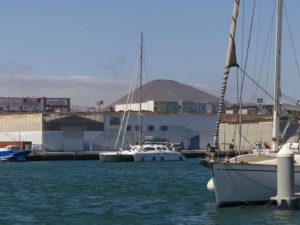New Thetis
Specification
Thetis, a Schionning Wilderness 1650, was designed by Jeff Schionning and built by a boatyard in Queensland, Australia in 2005.
Construction material: DuFlex balsa panels/epoxy.
Length: 16.50, Beam: 8:50
Life on Thetis
2024-2025: In 2024 Thetis spent the cyclone season on the hard in Vuda Boatyard while we did some travelling to Germany and to New Zealand. From July 2024 onwards we sailed her to the islands of Fiji, enjoying the Yasawas and also the remoter islands of the Lau group, including the Bay of Islands, Ongea and Fulanga. Instead of spending yet another cyclone season on the hard in Vuda we waited for a suitable weather window for the passage to New Zealand and arrived in Opua, NZ in November. The idea was to spend the NZ summer exploring the eastern coast and islands of NZ. But instead the boat was hauled out in Norsand Boatyard, Whangārei and stayed there all summer for refitting and renovations, while we returned to Germany now and then.
As mentioned above the sailing season of 2025 has been very short. When the boat finally left the boatyard it was time to consider the passage back to Fiji for the NZ winter. But there was no weather window promising a comfortable passage until fairly late in May. We sailed to the Bay of Islands and spent some nice days there only to find out that the chosen weather window closed again. In the end we returned the boat to Whangārei and left NZ for a long stay in Germany. To obey the NZ immigration rules we will return to the boat in December with the plan to spend part of the summer in NZ.
2023: August 2023: Fiji: Thetis loves the Fiji waters and we love them, too, plus the friendly people here. Such a difference in lifestyle between the two major islands and the ‚outer‘ ones. Suva is a real city, Savusavu a bustling little town where you are regarded as a permanent inhabitant after a fortnight’s stay. And on the outer islands: Subsistance economy, there are no cars, no roads, boats are the means of transportation. Children are taken to a boarding school in another village by boat once a week. The only paid jobs are in resorts on the same or another island. People are happy about their solar panel – one for each household- sponsored by the government. But they have no idea how to handle it if it fails to work. Even in a bay you are in the grounds of one village and are expected to ask the chief to be permitted to anchor there. Sevusevu with a gift of kava to the chief or headman opens the village and the bay to you as a sailor.
Fiji waters are mostly clean with a lot of coral and reefs everywhere.
July 2023: We have said goodbye to all our sailing friends in ARC World after some relaxing days in Muscet Cove, Malololailai Island. They are in a hurry to continue to Vanuatu and Australia to finish their circumnavigation within 15 months. We are reluctant to leave the Pacific so fast and have decided to stay for another six weeks at least. We should have done that much earlier!
June 2023: We have arrived in Copra Shed Marina,Savusavu, Vanua Levu, Fiji. This is a nice and very busy little town. Our guests Anne and Chris have left to go home to England and Hermann has left for Germany.
Mai 2023: We are back on board from a trip to Germany. Klaus (and Jasper) stayed on board while we were gone. We have brought StarLink with us. What a game changer. From Tahiti we went to Raitonga, where Anne and Chris have come on board to join us until Fiji.April 2023: We have arived in Tahiti with Klaus and Jasper and have found a convenient anchorage between the airport and the marina in front of a little park. it has been quite a rush through the beautiful Marquesas and Tuamotu islands. We would love to go back there, against the prevailing winds, alas.
February 2023: We have reached the Pacific! Interesting places on the way: San Blas Islands, Santa Marta and a trip to the Columbian mountains, Shelter Bay with a trip to an Indian village on Chagres River, the Panama canal and racoons in Panama City. Now we are in the Las Perlas and soon on our way to Galapagos.
January 2023 We will soon leave St. Lucia with the World ARC together with about 25 other boats. We plan to go to Australia only and stay there for the next cyclone (that’s what hurricanes are called there) season.
February 2022: Back in the Caribbean after 23 days of crossing in mostly feeble winds (or no wind at all) we are leisurely moving up the island chain from Gremnada to wherever we get before we have to return to Grenada for the hurricane season.
September 2021: In the Canary Islands again for a long stop in Lanzarote. We are planning a haul-out and new antifouling (coppercoat). Klaus has been good company to here here and will also join us for the planned Atlantc crossing in January 2022.
August 2021: After two years of hard restauration work and Covid 19 restrictions we are now on the move again. Eight months in Montenegro and one year in Manfredonia have turned Thetis into a seaworthy ship again. We are on our way to Cartagena where we will meet Klaus, our third crew mwmber for the next few months.
Old Thetis

Construction:
Thetis, a Tropic 12, was built by Samuel Boudon in La Rochelle, France. The boatyard, Naval Force 3, is a small boatyard specialized in custom-built boats of quality craftmanship. The Tropic 12 was only built twice in this version. ‚Boutique catamaran‘ is a title she deserves with justification.
Under water: solid GRP plus 1 layer epoxy, 2 layers epoxy primer, 2 – 5 layers Jotun Megayacht antifouling (2017), above water: plywood/epoxy. All surfaces inside the boat are either solid wood or veneered marine grade plywood in maple. All painted areas inside and outside are 2K PU paint (AWL Grip). The hollow keels are single skin laminate to withstand grounding and are independent of the hull structures.
The rudders are semi balanced with shafts of 2 inch diameter aluminum rods.
The steering system is hydraulic (Robertson RPU 160 hydraulic pump + Lecomble& Schmitt hydraulic cylinders) driven by the wheel (LS30 Lecomble & Schmitt) mounted in the cockpit. Emergency steering access is available in each hull. Two independent autopilots are available.
Accomodation (please click on pictures to see the full layout plans)
The saloon contains a six seat dining table with U- shaped settee, chest of drawers and full size chart table with electric control panels, VHF transceiver, AIS, radar and radio. Plenty of storage room in compartments and shelves behind and under the settee. Headroom differs from 1,80 m in the center close to the back and goes down to 1,75 and 1,70 towards the dining table/settee and the sides.
The galley on the port side of the saloon consists of a gas stove (3 burners), a gas oven/grill, double sink, fridge WAECO MODEL 54 (90 liters), ample space in various cupboards and drawers. A shower room is next to the entrance with space for wet clothes.
The starboard hull consists of a double bed above the engine-room with a Smartvent solar ventilator, plenty of storage room in a wardrobe, shelves and lockers with sliding doors, a single bed and a heads compartment (toilet with a JABSCO manual pump, washbasin). The bow space (watertight) is accessible through a hatch in the deck and contains a crash box, a sewage tank and plenty of space for sails. More storage room (bikes) can be found in the stern.
The port hull is alike, but with the watermaker control panels in the bathroom and the watermaker added in the bow. Both hulls have a headroom of 1,92 m.
Cockpit
The cockpit is protected by a hard bimini with LED lighting (2016). A flexible awning and 2 further 70%-sunproof awnings can be added, if the mainsail is not in use (all 2016).
The cockpit has U-shaped benches with teak grating. The position of the central steering wheel enables the person in charge (if he/she really wants to hand-steer) to stand or to sit on a high seat under the bimini. This seat can be taken away or adjusted to a normal seating position. A folding table can complete the cockpit.
Access from the cockpit to the saloon is through an acrylic glass door. The lower part of the door can be protected by a customized wooden hatch board against water in very heavy weather. (We have never had to use it, as breaking waves have never reached the cockpit.)
In the middle of the cockpit is a flush mounted locker covered by a wooden grating for gas bottles and diesel jerry cans.
Thetis is sailed entirely from within the cockpit. Apart from setting up or taking down the spinnaker all reefing and sail trimming operations are handled from there. Nobody needs to leave the safety of the cockpit during sailing. This ensures that while one person is on watch, the other can sleep soundly.
Rigging
Thetis is equipped with a 16 m (48 ft) carbon fiber mast with a three point rig. The rigging consists of 16 mm Dyneema shrouds and a 10 mm Dyform stainless steel forestay with a fitted Profurl C420 roller reefing system (2015).
The main runs in FACNOR aluminum tracks with Facslide F 10 recirculating ball bearing cars. It is reefed by 3 in-boom reefing lines led back to the cockpit from the mast.
Guard rails are 6 mm Dyneema supported by stainless steel stanchions, with stern gates.
History
In the first phase of her history Thetis was stationed in the mouth of river Ems in Germany during the summer months and was sailed in the North- Baltic-, Mediterranean Sea and North Atlantic. For winter storage (half of her lifetime) she was taken up river Ems to her home town, Haren, Germany, where she spent the winters in the dry under a tent. Time enough for regular maintenance and modernization. Most of the sailing was done with a crew of two. Thetis can easily be handled by two persons only. She has never been in charter!
In all those years Thetis had proved herself sturdy enough for serious blue water sailing and plans were made to take her across the Atlantic. This decision led to quite a few further changes concerning her bluewater sailing capabilities. Her 14.50 m aluminum mast was exchanged for a 16 m carbon fibre one in 2015, longer than before. but much lighter. Most of the standing- and partly running rigging is now Dyneema. To offer protection from the tropical sun a hardtop bimini was constructed in a carbonfiber- sandwich laminate. All of this has improved Thetis‘ general sailing performance and suitability for the tropics.
All lifelong modernization measures do not make Thetis a new boat, of course. But apart from her hulls, deck, furnishing and engines there is nothing left on board of what the boatyard built in in the year 1990. And what is left from those days has regularly been serviced or renewed when needed. Many other parts, electronics in particular, have regularly been brough up to date. All in all Thetis now has a virtual age of – say – 18 years, which would mean she was built in about 2000.
In July 2016 Thetis started her longest voyage so far: as part of the Barbados 50 fleet from the Canaries to Barbados, where she arrived in November 2016. On this long voyage Thetis proved herself a willing, fast and safe boat. The crew also enjoyed the independence, which enough solar-generated power, a watermaker and a rain catchment system give you. As a result the boat arrived with full water- and diesel-tanks. While other boats, also new ones, had suffered massive failure of their systems, ther had not been the slightest complaint. The crew of two was rested and relaxed.
Thetis has been sailed by her regular crew in the Caribbean since then. This will continue unless a new owner for her is found with a heart for a ship with a personality, standing out of the masses of built-to-be-chartered boats. Thetis has never been in charter and she has never been in a hurricane. There are no repairs pending and she is ready for her next 50,000 miles.
Location
Thetis is currently (2018) sailed in the Southern Caribbean Sea or – during the hurricane seasonon – she is on the hard in Grenada. She is planned to be re-launched on October 30.



